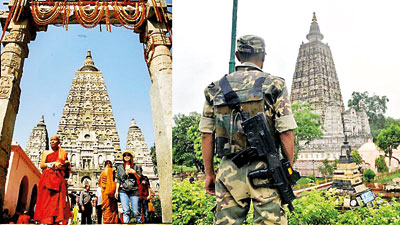Sunday Times 2
Mahabodhi dispute: Buddhism’s struggle against appropriation
View(s):- For Buddhists, the Mahabodhi temple represents identity, inspiration, faith and sacredness.
Buddhists have the right to control it
By Jadumani Mahanand
For the past few decades, religion has been at the centre stage of Indian politics. It’s mostly Muslim religious places that have become contested zones. Furthermore, non-Hindu and indigenous local traditions have seemingly been appropriated and co-opted as part of the Hindutva project. Against this backdrop, the protest at the Mahabodhi temple carries a different story. There is no Muslim invasion, but a temple under Brahmin control. Since February 2025, Buddhist monks have been protesting, seeking to reclaim control of Mahabodhi.
However, this demand is not new. It goes back to the late 19th century when Anagarika Dharmapala, a Sri Lankan Buddhist monk, protested against Brahmin control. Today, there is another Buddhist monk, the octogenarian Bhante Surai Sasai, who has been fighting for the same cause for decades. To understand this contested space, one needs to understand the suppression of Buddhism from a historical perspective.

A security personnel keeps vigil at the Mahabodhi Temple. (Express/Prashant Ravi)
In his essay ‘Revolution and Counter-revolution in Ancient India’, B R Ambedkar noted that Indian history has to be understood as an ideological battle between Buddhism and Brahmanism. According to Ambedkar, Buddhism was an egalitarian philosophy, and Brahmanism was established on chaturvarnya (graded inequality). Notably, he added that Buddhism was not sidelined because of Islam but because of Pushyamitra Sunga — a Brahmin king who allegedly deployed an army to attack Buddhist monks.
Further, he pointed out that 75 per cent of Buddha’s followers were Brahmin. Buddhist concepts like maitri, karuna, udita were included in the Upanishads, the Bhagavad Gita, and other Brahminical texts. However, a problem that persists is that Buddhism was co-opted by Brahmins and treated as part of their religion. Political leaders and Brahmin Hindu priests treat Buddha as the ninth incarnation of Vishnu. Arguably, several Hindu temples contain Buddhist monuments. Historically, in the periphery of Buddhist temples, one would find Hindu temples — for example, in Dhauli, Bhubaneswar, Ratnagiri and Udayagiri. Similarly, one finds Buddhist shrines, images and monuments in Tirupati Balaji temple and Kamakshi temple in Kanchipuram, but they are worshipped through Hindu rituals.
According to historian D N Jha, “Not only did Brahmins vandalise and appropriate Buddhist sites and monuments, they targeted Jain monuments as well.” Jha also claims that the decline of Buddhism started during the time of Shankaracharya during the eighth and ninth centuries. Ambedkar, nonetheless, puts it differently: “Buddhism declined in India because of the rise of Vaishnavism and Saivism, the two cults which adopted and absorbed many good points of Buddhism.” One may further get a clear perspective by reading Ambedkar’s interpretation of Indian history. His conversion was Buddhism’s moment of revival. Ambedkar’s articulation completely rejects Brahminical Hinduism. One of Ambedkar’s 22 vows, pronounced during conversion, was: “I do not and shall not believe that the Lord Buddha was the incarnation of Vishnu. I believe this to be mischievous and false propaganda.”
The struggle for Mahabodhi’s freedom needs to be put in historical context. The demand put forth by the Buddhist people to repeal the Bodh Gaya Temple Act, 1949 is a genuine constitutional demand. In 1892, an archaeological survey by Alexander Cunningham confirmed that Mahabodhi was originally a Buddhist site. It is difficult to find people of other religions controlling the operations of Hindu temple committees. Mahabodhi shouldn’t be an aberration. For Buddhists, the Mahabodhi temple represents identity, inspiration, faith and sacredness. Buddhists have the right to control it.
(The writer teaches at O P Jindal Global University)
Courtesy Indianexpress.com

